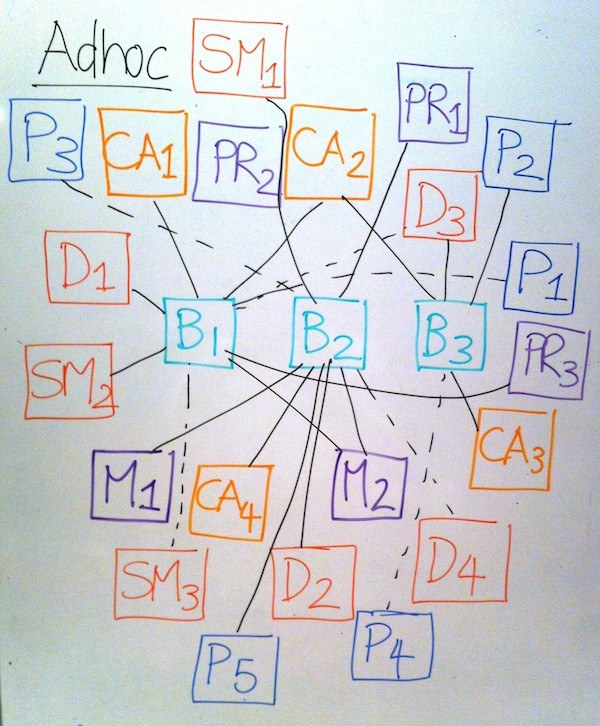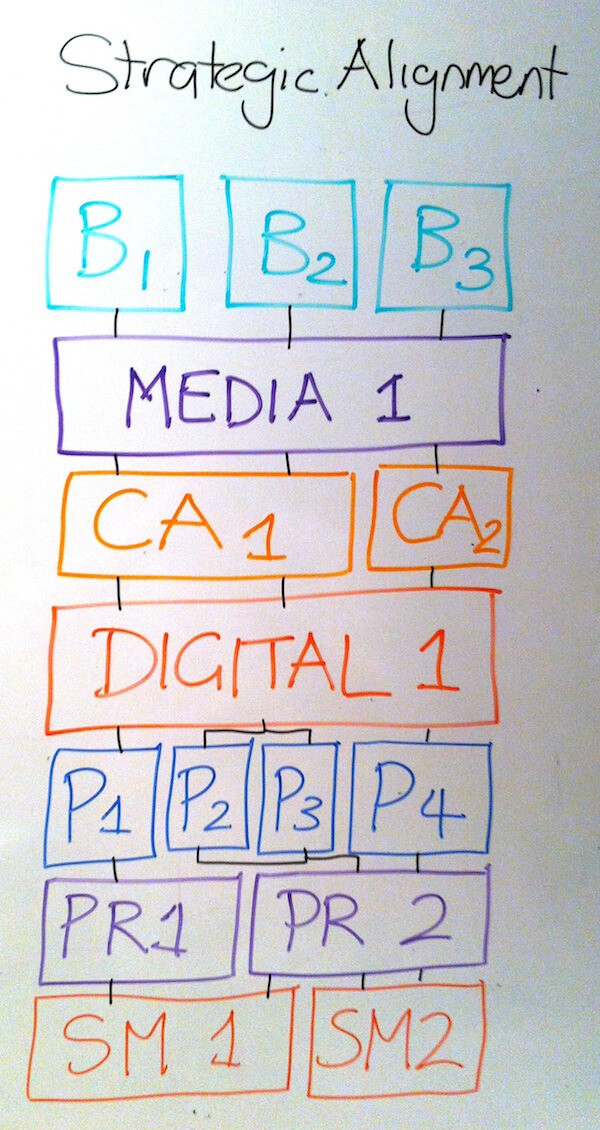It is interesting to see how so many marketers structure their agency arrangements. I would have to say the vast majority will certainly have defined roles for their media and creative agencies but then have a more adhoc approach to their other agency vendors such as digital, social media, sale promotion, retail, pr, direct markets, behaviour marketing, events and the like.
It is often the case that the marketer’s agency roster will be a fairly traditional adhoc structure which has developed organically in response to an immediate need rather than built to specific strategic requirements.
Traditional common practice
In this case we have:
Brand teams – B1, B2, B3
Media Planning & Buying – M1 & M2
Creative Agency – CA1, CA2, CA3, CA4
Digital Agency – D1, D2, D3, D4
Promotional Agency – P1, P2, P3
Social Media – SM1, SM2, SM3
Public Relations – PR1, PR2, PR3
The concept that 3 brand teams could be engaging 19 or more marketing vendors is not unusual. In fact there are often many more if you include graphic design, research etc. I have been in discussions with marketers and procurement where more than 100 separate vendors have been identified on the current roster.
When procurement begins to look at marketing and identifies the number of suppliers then they will quite rationally propose a panel structure where suppliers are reviewed and rationalised (reduced) into a number of panels based on their core competency.
The argument being that the reduction in the number of suppliers will lead to economies of scale and therefore a reduction in cost. But as we have discussed previously there are many issues with this panel structure, one being it usually under-delivers to the marketers needs and therefore is unsustainable.
Procurement based panels
I have often been consulted by marketers who feel their current roster and specifically the panel structure is not working. On review it is usually because:
1. The panels are too loose on structure and definition, after all, what is a digital agency and do you have the breadth of digital capabilities.
2. The panels are poorly structured with too many of the same quality of suppliers in the panel, usually the lowest cost, and so marketers feel they need to go outside the panel to get the quality of supplier they need.
3. The panels have inappropriate suppliers within them due to a lack of rigour in the selection process, with one digital panel we reviewed having a virtual reality specialist in the mix and at the other extreme a public relations company pretending to be a platform builder when they outsourced all of these functions.
A more sustainable and smarter way to manage your agency roster is to align the suppliers to your strategic marketing requirements by brand.
Assuming that the marketing requirements are developed directly from the business objectives, this means that you select and appoint your suppliers on the ability to contribute and drive your business objectives.
Strategic agency alignment
We have found the benefits of this process are:
1. This places a focus in marketing on delivery of the business and marketing objectives from the brand teams right through to the smallest supplier.
2. The strategic nature of the structure delivers a greater level of commitment to this process than the more ad-hoc and capability focused approaches.
3. Each supplier has a clear strategic role and responsibility so managing the roster is easier because this creates a structure that all suppliers can operate within
And for those who feel this locks in the roster and creates inflexibility, we have found that the structure allows you to quickly identify where changing requirements or underperformance is occurring and quickly address this, more so than in the other approaches where this can be hidden by the lack of transparency in roles and responsibilities.
What do you think? Please leave a comment with your opinion.








3 thoughts on “Why it is essential for agencies to be part of your business strategy alignment”
A great example of taking bad to good.
Builds better relationships and creates greater value for all.
While the proposed structure is ideal, it can be achived by a good relationship between marketing and procurement and that both empathise with each other. Why? because marketing wants liberty to use vendors to apply their creativity and procuremnet intends to control supply base. So if both sides make the business requirements clear and empathise, this does not seem difficult. and this is real in my organisation.
Manoj, I have found that the flexibility you talk about in some cases is lack of decision making. Both can be accommodated by tasking a strategic approach to vendor selection and management. I have found that the panel of supplier structure gives the appearance of flexibility but often the composition of these panels does not meet the strategic needs of marketing. Therefore a more effective method here is to start with the strategic needs and build the vendor structure to it.
Comments are closed.